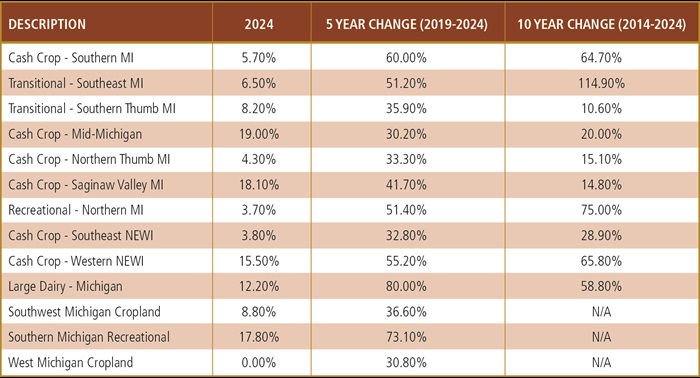
How Land Value Benchmarks are Determined
Every year, annual land value trends are observed by GreenStone Farm Credit’s team of expert appraisers. These trends are measured by re-appraising the same thirteen plots of land representing unique market areas in Michigan and northeast Wisconsin. GreenStone evaluates these properties annually to give landowners and customers a picture of how the value of cropland, transitional land, recreational land, and dairy improvements have changed throughout the past year. Factors such as commodity prices, governmental regulation, tourism, and weather all help determine the market value of land within these regions. Reevaluating the same plots of land every year also eliminates any variance that could occur with other survey methods, leading our appraisals to the best representation of market value trends.
The Results are In
Overall, the results across all thirteen benchmarks grew again this year as you can see in the table below. For the fourth year in a row, land values only increased, ranging from a 3.7% increase all the way to 19%. For landowners, these results ring positive, but for those looking to acquire land, these rising prices continue to present challenges. Many aspiring landowners are now facing all-time-high land prices coupled with challenging commodity price outlooks. Despite these realities, demand for land remains high and inventory is scarce. With this competitive environment, it’s easy to see why we’re noting significant positive gains in value across the board for all thirteen land benchmarks.

Dairy and Cash Crop Summary
In 2023, our value benchmark representing a CAFO sized dairy operation saw a historic year-over-year increase in value due to rising construction costs and a thriving dairy market. That trend somewhat moderated but continued into 2024 with a 12.2% increase in value for large dairy operations in Michigan and Wisconsin. As this trend is heavily influenced by construction costs, the benchmark has nearly doubled in value over the past four years.
Land benchmarks for cash crops continued to hold steady in the northeastern Wisconsin region with a year-over year increase of 3.8%. The western part of northeast Wisconsin saw another spike in land value due to rising competition for limited land. This trend has been constant in the region over the past several years and appears it will remain the same going forward. In keeping with the trend, all Michigan cash crop value benchmarks also experienced steady increases in value.
Recreational and Transitional Summary
Recreational land and transitional land (agricultural land expected to be developed into another use in the future), continued to experience increases in value. However, that increase was not as significant as it has been in years prior. The period directly following the COVID-19 pandemic showed a widespread movement of people leaving urban areas to more rural destinations or purchasing recreational land. That trend seems to be leveling off, as the value of these land types has become more moderate in the past year. This trend can be seen across the land benchmarks in Michigan’s southeast and southern thumb regions, and northern Michigan. Increased interest rates, inflation, and other economic factors all play a role in the decreasing strength of land values.
It's Still a Good Time to Own Land!
An unwavering fact from this year’s land benchmark results is the value of land continues to increase, and the good news for landowners is it’s very likely the value of your land has increased over the past year. Buying land continues to be a strong investment for your future!
GreenStone’s team of financial experts can help find a unique solution that’s tailored to you, whether that’s helping you secure your dream plot of vacant land or expanding your farming operation. Click here to learn more about the resources GreenStone provides when it comes to purchasing land.
This blog was originally published in Michigan Farm News.


